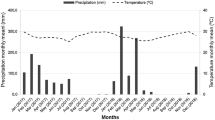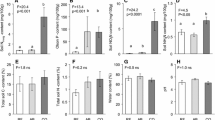Abstract
On Île de la Possession (Crozet Archipelago, sub-Antarctica), the testate amoebae (Protozoa, Rhizopoda) fauna in soils around abandoned and occupied nests of the wandering albatross (Diomedea exulans) was investigated. A comparison with control samples, a cluster analysis and several ordination techniques indicated that the presence of the breeding albatrosses induced modifications in physico-chemical soil characteristics and in the soil inhabiting testacean fauna. Only 11 testate species occurred frequently in the soils in the albatross’ zone. Soils around occupied nests had significantly higher moisture values, less acid pH values, an increased specific conductance and elevated phosphate and ammonium concentrations. Highly influenced testacean communities were characterised by high abundances of Difflugiella oviformis and extremely high abundances of Trinema lineare, resulting in a very low diversity and evenness within these communities. The intermediary situation of one abandoned nest indicated that soils around abandoned nests evolve gradually back to undisturbed soils. Although an overall negative influence on the testacean diversity, a limited albatross’ influence may increase the living fraction within the testacean soil communities.





Similar content being viewed by others
References
Birdlife International (2006) http://www.birdlife.org/datazone/sites/index.html?action = SitHTMDetails.asp&sid=6897&m=0
Decloître L (1962) Le genre Euglypha Dujardin. Arch Protistenkd 106:51–100
Decloître L (1978) Le genre Centropyxis I. Compléments à jour au 31 décembre 1974 de la Monographie du genre parue en 1929. Arch Protistenkd 120:63–85
Decloître L (1979) Le genre Centropyxis II. Compléments à jour au 31 décembre 1974 de la Monographie du genre parue en 1929. Arch Protistenkd 121:162–192
Decloître L (1981) Le genre Trinema Dujardin, 1841. Révision à jour au 31 décembre 1979. Arch Protistenkd 124:193–218
Deflandre G (1928) Le genre Arcella. Arch Protistenkd 64:152–288
Deflandre G (1929) Le genre Centropyxis. Arch Protistenkd 67:322–375
Deflandre G (1936) Etude monographique sur le genre Nebela Leidy. Ann Protistol 5:201–327
Gillham ME (1956) Manuring by the colonial seabirds and mammals with a note on seed distribution by gulls. J Ecol 44:429–454
Grospietsch T (1964) Die Gattungen Cryptodifflugia und Difflugiella (Rhizopoda, Testacea). Zool Anz 172:243–257
Hoogenraad HR, de Groot AA (1940) Zoetwaterrhizopoden en—heliozoën. In: Boschma H. Fauna van Nederland IX, Leiden pp 1–303
Joly Y, Frenot Y, Vernon P (1987) Environmental modifications of a Subantarctic peat-bog by the Wandering Albatross (Diomedea exulans): a preliminary study. Polar Biol 8:61–72
Jongman RH, ter Braak CJF, van Tongeren OFR (1987) Data analysis in community and landscape ecology. Pudoc, Wageningen
Kovach Computing Services (2002) Multivariate statistical package, version 3.1. Users’ manual. Kovach Computing Services, Pentraeth, Wales
MacQuaker NR (1976) A laboratory manual for the chemical analysis of waters, wastewaters, sediments and biological tissues, 2nd edn. Department of Environment, Water Resources Service, Province of British Columbia
Nijssen D, Rousseau R, Van Hecke P (1998) The Lorenz curve: a graphical representation of evenness. Coenoses 13:33–38
Ogden CG (1983) Observations on the systematics of the genus Difflugia in Britain (Rhizopoda, Protozoa). Bull Br Mus Nat Hist Zool Ser 44:1–73
Ogden CG, Hedley RH (1980) An atlas of freshwater testate amoebae. Br Mus Nat Hist Oxford University Press, Oxford, pp 1–222
Shannon C, Weaver W (1949) The mathematical theory of communication. University of Illinois, Urbana
Smith VR (1978) Animal–Plant–Soil nutrient relationships on Marion Island (Subantarctic). Oecologia 32:329–253
Ter Braak CJF, Prentice IC (1988) A theory of gradient analysis. Adv Ecol Res 18:271–317
Ter Braak CFJ, Smilauer P (1998) CANOCO Reference Manual and User’s Guide to CANOCO for Windows. Software for canonical community ordination (version 4). Centre for Biometry, Wageningen
Van de Vijver B, Beyens L, 1999. Freshwater diatoms from Ile de la Possession (Crozet Archipelago, sub-Antarctica): an ecological assessment. Polar Biol 22:178–188
Van de Vijver B, Ledeganck P, Beyens L (2002) Soil diatom communities from Île de la Possession (Crozet, sub-Antarctica). Polar Biol 25:721–729
Vincke S, Ledeganck P, Beyens L, Van de Vijver B (2004a) Soil testate amoebae from sub-Antarctic Îles Crozet. Antarct Sci 16:165–174
Vincke S, Beyens L, Van de Vijver B (2004b) Freshwater testate amoebae communities from Île de la Possession, Crozet Archipelago, Subantarctica. Arct Antarct Alp Res 36:584–590
Vincke S, Gremmen N, Beyens L, Van de Vijver B (2004c) Moss dwelling testacean fauna of Île de la Possession. Polar Biol 27:753–766
Acknowledgments
The sampling was made possible by the logistic and financial support of the French Polar Institute (IPEV) in the frame of two Terrestrial Programs BIOSOL 136 (Dr. Yves Frenot & Ir. M. Lebouvier, Université de Rennes, France) and DIVCRO 405 (Prof. Dr. Louis Beyens & Prof. Dr. Ivan Nijs, Universiteit Antwerpen, Belgium). Dr. Niek Gremmen is thanked for his valuable comments and advice on statistical questions.
Author information
Authors and Affiliations
Corresponding author
Rights and permissions
About this article
Cite this article
Vincke, S., Van de Vijver, B., Ledeganck, P. et al. Testacean communities in perturbed soils: the influence of the wandering albatross . Polar Biol 30, 395–406 (2007). https://doi.org/10.1007/s00300-006-0196-4
Received:
Revised:
Accepted:
Published:
Issue Date:
DOI: https://doi.org/10.1007/s00300-006-0196-4




